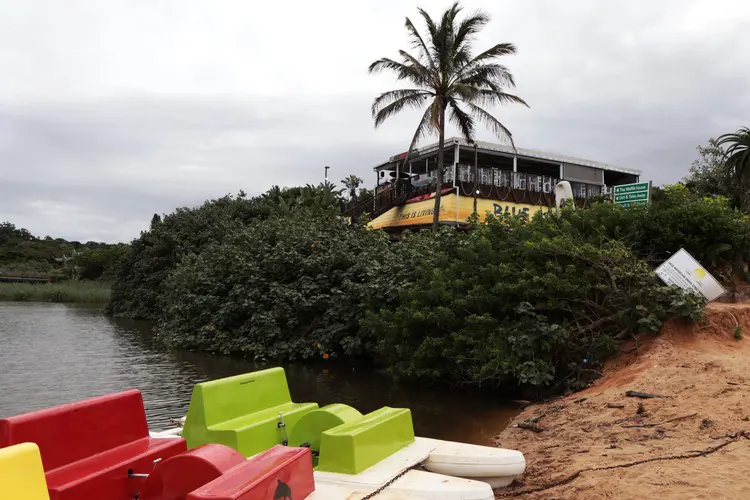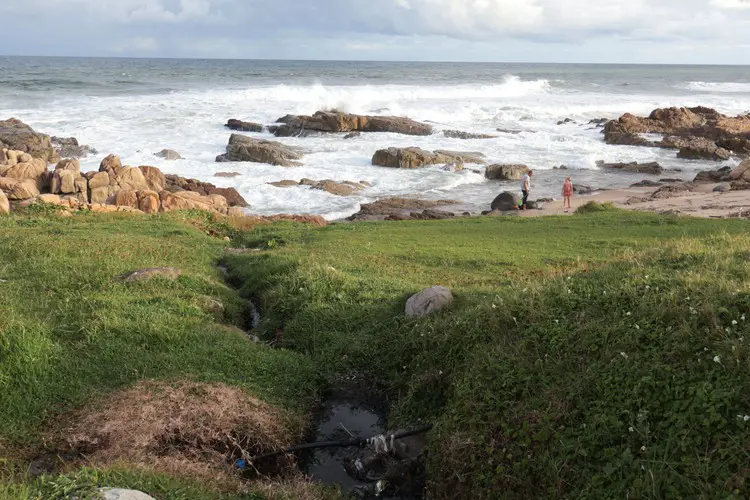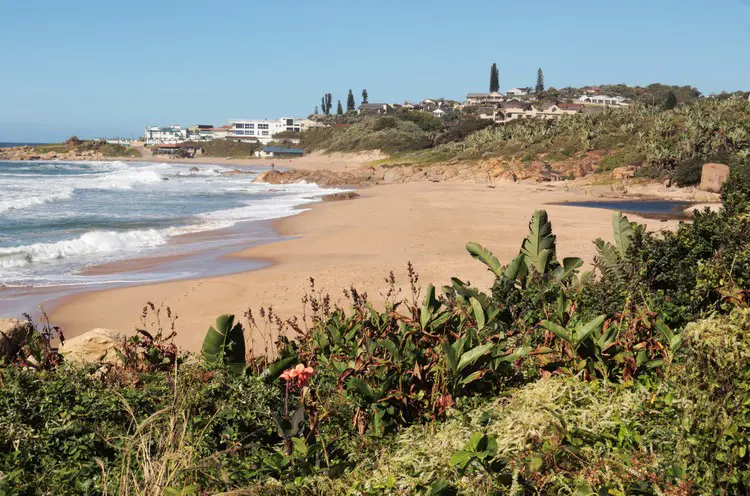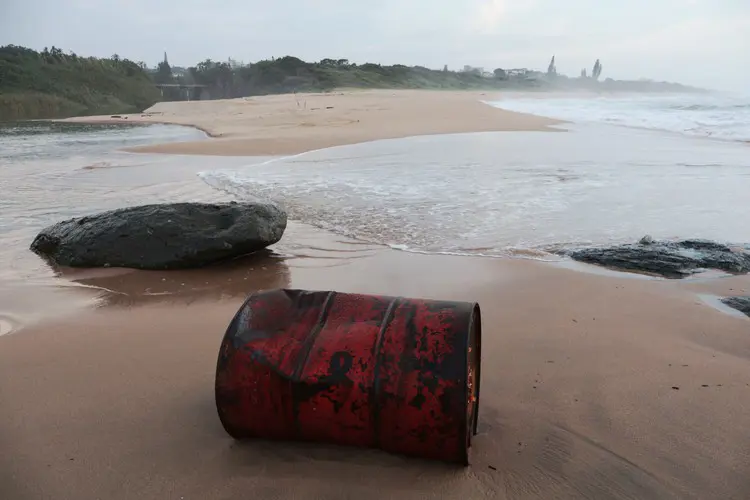Sewage seeps into KwaZulu-Natal’s popular south coast lagoons
None of the 19 sewage treatment plants managed by the Ugu District Municipality are properly treating sewage released into rivers and lagoons.

The river that flows out to sea at Margate’s main beach is fed with up to 7-million litres of effluent per day from a failing sewage treatment plant about 1.8km upstream. Picture: Steve Kretzmann/GroundUp
Lagoons and beaches at popular tourist destinations like Margate and Ramsgate on the KwaZulu-Natal south coast are polluted with sewage.
Currently, not one of the 19 sewage treatment works within the Ugu District Municipality, which stretches from Scottburgh in the north to Port Edward in the south, is working properly, information from the Department of Water and Sanitation (DWS) shows. The department publishes the results of monthly effluent quality tests Integrated Regulatory Information System (IRIS) from each sewage treatment plant in the country.
Each plant is supposed to treat sewage to minimum national standards before releasing the effluent into the environment. Along the south coast, 15 sewage treatment plants within the Ugu municipality release untreated, or at best partially treated, effluent into rivers just a couple of kilometres from the sea, where they form lagoons at the beach. The other four plants in the municipality are further inland, such as in Harding.
The warm, shallow lagoons are ideal for swimming and paddling, especially for children, but many are severely contaminated by the failing upstream sewage plants, as well as from leaks and overflows from crumbling sewerage infrastructure.
Lifeguards at Ramsgate main beach warn people not to enter the lagoon. A faded sign warning of health risks due to the contaminated water has fallen over and is partly obscured by bushes.
The Ramsgate sewage plant does not discharge into the Bilanhlolo River that forms the lagoon at Ramsgate main beach, but the pollution is due to overflows at manholes, pump station failures, and breaks in the sewerage pipes.
The sewage plant at Ramsgate releases about 1-million litres of partially treated sewage per day into the Little Bilanhlolo River, which forms a lagoon at the next cove, about 500 metres away. As this is not a main beach, there are no signs or lifeguards to warn against swimming in the Little Bilanhlolo lagoon.

A faded sign that has fallen over warns that the lagoon at Ramsgate main beach is 'under strict monitoring for any possible contamination'. While this river, the Bilanhlolo, does not have a sewage treatment works releasing effluent into it, it is regularly contaminated by sewage spills. Picture: Steve Kretzmann/GroundUp
NO WARNINGS
At Margate, lifeguards GroundUp spoke to believed the lagoon they overlooked at the main beach was fine to wade in, and no warning sign could be seen. But the IRIS site shows the Margate sewage plant, which is failing, releases about 4-million litres of partially treated effluent per day into the river, just 1.8km upstream.
In fact, satellite maps show that the effluent from the sewage plant, along with stormwater from surrounding suburbs which is likely contaminated, is the main source for the river that flows out at Margate’s main beach.
Margate is the largest of the holiday destinations on the south coast, with multi-storey hotels and timeshare apartments lining the beachfront.
At present, effluent from the Margate sewage plant has a microbiological compliance rate of just 33%. This means the levels of E.coli – bacteria found in faeces – are within the maximum of 1,000 colony forming units (cfu) per 100ml in only 33% of tests this year. The effluent has complied with chemical standards (levels of nitrogen and ammonia, among others), in only 17% of tests.
These failure rates go back seven years, to 2017, which is as far back as data on the IRIS site is available.

A father and daughter explore the coast at Margate, oblivious to untreated sewage running out at the beach near them. Picture: Steve Kretzmann/GroundUp
OUT OF ORDER
GroundUp was blocked by security guards from entering the Margate and Port Shepstone sewage plants in early March, although a worker at the Margate plant, who did not want to give their name as they did not have permission to speak to the media, said: “Everything here is out of order.”
By chance, GroundUp arrived at the back gate at the bottom of the Ramsgate sewage plant, and, as the gate was unlocked and ajar, we walked in. A worker there pointed out that only one third of the equipment was working.
He said when sewage volumes were low enough, the workers simply pumped the sewage up from the bottom dam in order for it to go through the system again in the hope of improving the effluent quality. But this was not possible during school holidays when there were a lot of visitors and sewage volumes were high.
He said no maintenance or upgrading work had been done at the plant for 14 years.

The idyll of the south coast is undermined by pollution of lagoons such as where the Little Bilanhlolo River reaches the sea. Less than 1.5km upstream, the failing Ramsgate sewage treatment works releases up to 2-million litres of partially treated sewage per day. Picture: Steve Kretzmann/GroundUp
DON'T DISTURB TOURISM
The Ugu District Municipality failed to respond to questions, but numerous people interviewed by GroundUp said the municipality did not test the water quality in the sea or in the lagoons.
However, the Ray Nkonyeni Local Municipality within the Ugu District Municipality tests seawater at the beaches, although the results of the tests are not publicly available. A group of citizen scientists under the banner Green Town, also regularly test the water quality in 12 lagoons, from Hibberdene to Port Edward, but they were tight-lipped about the results, saying they did not want to damage tourism, the main source of income for the string of small coastal towns, and were worried about souring tenuous relationships with the municipality.
Ramsgate resident Andrew Loggenberg said he was one of a number of citizen scientists who took samples at their local lagoons every three weeks. These were sent to Olliver Ransome, who couriered them to a laboratory for analysis, and received the full set of results.
Asked if GroundUp could see the laboratory results, Ransome said he’d have to consult with the other Green Town members. He later responded via email that “the consensus is not to release individual lab reports to the media”. However, he forwarded a select batch of analysis results from samples the Ray Nkonyeni municipality had sent to the lab, saying they had been made public.
The samples from seven lagoons along the coast were received by B.N. Kirk laboratory on 22 January 2024. While five were within acceptable limits, two of them —- from Margate and Ramsgate — had E. coli and intestinal enterococci levels that exceeded South African water quality guidelines for coastal marine waters. The South African guidelines state more than 185 cfu/100ml for enterococci, and more than 500cfu/100ml for E. coli, is “unacceptable”, posing a health risk.
The Ramsgate lagoon sample had enterococci at 370cfu/100ml – twice the acceptable limit, and an E.coli level of 730cfu/100ml. Margate lagoon had enterococci levels of 840cfu/100ml —- more than four times the maximum limit - and E.coli levels at 1920cfu/100ml —- nearly four times the acceptable limit.
The date, 22 January, was after the school holidays and peak tourist season, indicating the pollution had continued in spite of a drop in population after the holiday season.

The mouth of the uMbango River, into which the Port Shepstone/uMbango sewage treatment works releases about 8 million litres of partially treated sewage per day. Picture: Steve Kretzmann/GroundUp
POLLUTED SEAS
The seawater samples were taken from the sea at 12 beaches along the coast roughly every two weeks between August 2023 and early February 2024. The analysis shows extreme sewage pollution at Margate beach during the height of the December/January holiday season.
Every sample from 18 December 2023 to the last one on 5 February 2024, shows pollution levels far in excess of acceptable levels. On 18 December 2023, 8 January 2024, and 22 January, E. coli levels were higher than 2,900cfu/100ml, which was as far as the laboratory measured. Even more concerning were enterococci levels, which were greater than 20,300cfu/100ml on 8 January, and 101,500cfu/100ml on 22 January. Faecal pollution also exceeded acceptable levels on 10 October and 20 November 2023, and on 5 February 2024.
While Margate beach has occasionally been closed due to sewage pollution, such as in August 2023, and this month, it is not known whether it was closed during the last summer holiday period.
Other beaches in the set of water quality results that recorded unacceptable faecal pollution levels were Lucien beach – four times between 29 August 2023 and 8 January 2024; Ramsgate – three times between 4 December 2023 and 15 January 2024; and Uvongo beach – on 8 and 22 January when E. coli levels were greater than 2,900cfu/100ml.
Managing member at the B.N Kirk laboratory, Dawn Bester, whom GroundUp called to clarify some technical terminology contained in the water quality analysis reports, said in her 30-year career in the “water industry”, she has “definitely seen deterioration in sea water quality” along the south coast.
Bester said pollution at Margate was of particular concern at the moment as sewerage infrastructure had been washed away during flooding on 14 April, in which five people died. As a result, raw sewage was flowing from broken pipes onto the beach. She said when laboratory staff went there to take samples they were told to disinfect themselves afterwards.
Questions sent to Ugu District Municipality had not been answered by the time of publication.
This article first appeared on GroundUp. Read the original article here.